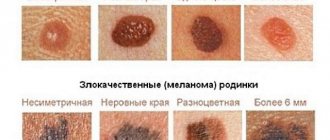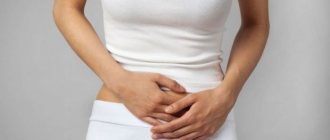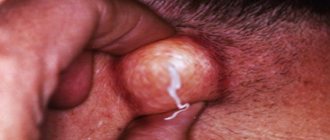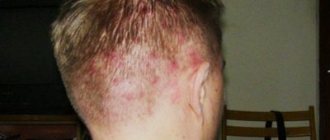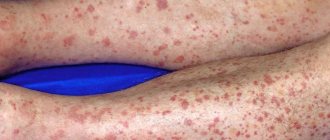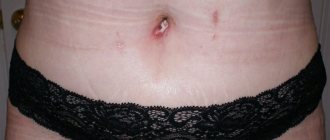Last updated: July 24, 2020
Allergic rashes in children are a very common and common occurrence. Most often, this disease manifests itself in the form of a rash, but the causes can be different. You will learn in this article how allergic rashes in children are treated and what they are like.
- For what reason does an allergic rash appear on a child's skin?
- What does a child's skin allergy look like?
- How to diagnose allergies?
- First aid and treatment
- What is done to prevent allergic rashes in children?
- Types of allergic reactions with photos
- Conclusion
Causes
Allergic rashes can occur in children from birth until the age of 7 years. This is explained by the fact that the immune system has not yet been formed. Below are the main causes of allergic reactions in children:
- Medicines, the body may react negatively to some components of medicines;
- Breast milk if the diet is not followed;
- Hygiene products and household chemicals;
- Plants and animals can also cause rashes;
- Ultra-violet rays;
- Various infections and diseases.
Eczema on hands
This is a common skin disease, the causes of which are associated with stress, mineral and vitamin deficiencies, poor diet and hormonal imbalance.
- red, inflamed papules, the appearance of which is typical on the skin of the hands, face and back;
- severe, unbearable itching, as a result of which the inflammatory process intensifies, and bleeding wounds appear at the site of the rash;
- the appearance of pustules at the sites of scratching.
An experienced specialist will prescribe a comprehensive treatment, which includes: multivitamins, antihistamines, sodium thiosulfate. It is also recommended to take sedatives such as hawthorn tincture, motherwort and valerian, and local remedies may include hormonal and antibacterial ointments. Only as a result of such comprehensive treatment can this disease disappear over time.
What do allergic rashes look like?
There are a large number of types of allergy rashes in children, it all depends on the irritant that caused it. In many cases, exanthemas appear on the child’s body (this is the name given to various manifestations of allergic rashes):
- pustules (filled with pus);
- plaques;
- spots;
- vesicles (filled with liquid);
- blisters (large vesicles larger than 0.5 cm).
With food allergies in children, the rash can be found primarily on the cheeks and near the mouth. With a contact allergy, a rash or irritation will appear in the area where the allergen touched. If the child’s body reacts negatively to medications, inflammation will appear in the area of the lymph nodes.
Factors
Let's consider the main factors:
- Allergic reaction. When the skin comes into contact with the allergen, small blisters or pimples with liquid or crust form on the fingers. They cause severe itching and burst, threatening the development of infectious diseases. If this problem is not solved in time, inflammation can spread to the joint of the hand. More often, allergens are chemicals contained in household chemicals, for example, detergent and powder. Less commonly, allergies are caused by cosmetics, such as ointments, or medications. You can determine whether the appearance of blisters is caused by an allergy by the time of their occurrence. If such a problem is seasonal, that is, it occurs in spring and autumn, then this means that the problem is caused by an allergy. Seasonality is primarily due to vitamin deficiency, nervous system tension and an increase or decrease in the level of exposure to sunlight on the skin.
- Measles or chicken pox. They cover the entire body and this problem requires a medicinal solution.
- An infectious rash is accompanied by general malaise and fever.
- Parasites. The scabies mite, which lays its eggs under the skin, is where blisters appear, all of which is accompanied by severe itching. To avoid this problem, you need to follow the rules of hygiene, wash your hands after public transport and try to avoid contact with an infected person and his things.
- There is no need to write off problems with the nervous system, constant psychological tension, frequent stress and prolonged depression will often cause the hands to become covered with blisters or a watery mesh to form on them.
If you find skin rashes after a tourist trip to exotic countries, you need to go to the clinic; these small blisters are associated with rare diseases that are not typical for our region.
How to diagnose allergies?
An allergic rash in children is often confused with an infectious one. If the treatment is incorrect, then the consequences of such a therapeutic course will not be the best. Before choosing an effective remedy, you need to learn to distinguish one disease from another. Only a doctor can make an accurate diagnosis, since a visual examination is not always enough to determine the cause of the disease; tests are required.
| Features | Allergic rash | Infection |
| General form | It can be in the form of both small dots and large blisters. In addition to them, there are often crusts, erosions and serous wells (ulcers from which fluid oozes). | The rashes are pinpoint and do not “merge” into a large spot. |
| Place of appearance | Face (forehead, cheeks, chin). Neck, arms, legs, buttocks. Rarely – stomach, back. | Belly, back. Rarely – arms, legs. Very rarely - forehead. |
| Heat | The temperature is rare, and if it rises, it is not higher than 37-38°C. | The disease is accompanied by fever, from 37°C to 41°C. |
| Itching | Happens. | Happens. |
| Swelling | Well visible. In some situations it is life-threatening. | They happen very rarely. |
| Associated symptoms | Lacrimation, conjunctivitis, hyperemia of the mucous membrane of the eye, decreased blood pressure, cough, upset stomach. | Running nose, general loss of strength, body aches. |
| How quickly it goes | Often the rash goes away immediately after taking the medicine. | Remains until the course of treatment is completed. |
Treatment methods for molluscum contagiosum
Molluscum contagiosum should be treated by a doctor. You should not try to remove papules yourself - this can lead to bacterial infection.
Treatment of molluscum contagiosum depends on a number of factors, primarily on the stage of development of the disease, the severity of symptoms and the state of the patient’s immunity. The following methods can be used:
Instrumental removal
Papules can be removed instrumentally, followed by treating the wound with antibacterial agents.
Credestruction
Cryodestruction is the removal of papules using exposure to low temperatures. Papules are treated with liquid nitrogen. Tissues treated in this way freeze and die.
Radio wave removal
Molluscum contagiosum papules can be removed using the radio wave method (using the Surgitron apparatus) and using a laser.
Electrocoagulation
Electrocoagulation is the effect of high-frequency current on papules. It is popularly described as “cauterization with electricity.” At the moment of discharge, a local strong thermal effect occurs, the tissues coagulate, which virtually eliminates the risk of infection at the treatment site.
Conservative treatment
The course of treatment for molluscum contagiosum may include conservative treatment with ointments and creams, as well as taking antiviral drugs (if the affected area is large).
Make an appointment Do not self-medicate. Contact our specialists who will correctly diagnose and prescribe treatment.
Rate how useful the material was
thank you for rating
First aid and treatment
If children develop an allergic rash on their skin, it is strictly forbidden to squeeze pimples or open blisters. It is necessary to explain to the child that it is also forbidden to scratch the sores.
If he is still too small, make sure that he does not touch the wounds with dirty hands. He can get an infection, and this will only worsen his condition.
Treatment of rashes in children is selected depending on the type of disease. Parents who do not know how to treat allergic rashes in children should not select medications on their own.
Methods for diagnosing molluscum contagiosum
Molluscum contagiosum can be confused with manifestations of other diseases, including serious ones such as syphilis or cancer. Also, the activity of the molluscum contagiosum virus increases with a decrease in immunity, so in 20% of cases molluscum contagiosum accompanies HIV infection. This means that when rashes appear that correspond to the description of molluscum contagiosum, a medical examination is required to rule out such options.
When contacting a dermatologist, the doctor will examine the patient, make a diagnosis and suggest a treatment method.
Inspection
In most cases, the diagnosis of molluscum contagiosum is made by a dermatologist based on the results of an examination of the patient.
PCR diagnostics
Since HIV often accompanies molluscum contagiosum, PCR diagnostics for HIV can be prescribed.
More information about the diagnostic method
Serological blood test
When molluscum contagiosum is detected in adults, a serological blood test is prescribed to identify sexually transmitted infections (hepatitis B and C, HIV, syphilis, etc.).
More information about the diagnostic method
Sign up for diagnostics To accurately diagnose the disease, make an appointment with specialists from the Family Doctor network.
How to avoid allergies in children?
Preventive measures will prevent the child from developing an allergic rash. Doctors give the following recommendations:
- Make sure that the baby does not come into contact with the allergen (remove allergenic foods from his diet; if necessary, change baby powder, soap or dishwashing liquid.
- Maintain order in his room, regularly do wet cleaning.
- If there are pets in the house, keep them clean.
- Strengthen the baby’s immunity (walk more often, play sports).
- Do not violate your doctor’s recommendations for taking medications.
Insufficiently thorough skin cleansing
If small red pimples appear on your hands, the reason may be very banal - insufficiently thorough cleansing of the skin from existing impurities and dead particles. Such pimples are usually small in size, there are many of them, and they often itch. Such rashes very rarely appear on the wrists and hands. Favorite places are the forearms and elbows. To get rid of the problem, regularly cleanse your skin with scrubs, use a hard washcloth, and moisturize your skin with milk, lotion or cream. If the above measures do not help, you may need to cleanse your skin more thoroughly. You can visit a cosmetologist's office and have deep skin peeling or normalize the activity of the sebaceous glands using darsonvalization.
Examples of rashes with photos
Colorless rash "goosebumps"
Exudative diathesis
Hives
Food allergies
Bacterial infection
If a child is infected with streptococcus on the body, blisters with liquid may appear on the skin, which can be seen in the photo below. The pathogen penetrates the surface layer of the epidermis through the slightest damage to the skin (insect bite, scratch).
First, bright red spots appear, after a day they are covered with bubbles with a cloudy liquid. As the pathological process progresses, the vesicles burst and the purulent contents flow out. When dry, hard yellow crusts form. The child is bothered by itching and burning. The disease is called streptococcal impetigo.
Children from the neonatal period to 2 years get sick. The rash is localized on the extremities, rarely spreading to the trunk and face. In newborns, vesiculopustulosis is observed - single or multiple blisters with purulent watery contents. The predominant localization is the inner surface of the limbs, natural folds of the body, and torso.
A more severe type of rash is pemphigus - neonatal pemphigus. Flaccid blisters of various sizes appear on the child’s skin (on the chest, abdomen, on the flexor surfaces of the limbs). The bubbles quickly open, the liquid contents dry out, forming a crust. The process is superficial: the deeper layers of the skin are not affected. The causative agents are coccal microbes, Escherichia coli and Pseudomonas aeruginosa, Klebsiella, Enterobacter.
Recommended Supplements for Treatment
Fish Oil Dose: 2 capsules per day or 600 mg omega-3 fatty acids Caution: Do not exceed dose if you are taking blood thinners. Evening primrose oil Dose: 500 mg 3 times a day primrose Namely: you can replace it with the same amount of cucumber oil 1 time a day
Evening primrose oil Dose: 500 mg 3 times a day primrose Namely: you can replace it with the same amount of cucumber oil 1 time a day.
Zinc Dose: 15 mg per day Caution: If you are taking a zinc supplement for more than 1 month, choose a product that contains 1 mg copper. Vitamin E Dose: 50 mg per day Namely: it is better to use vitamin E in its natural form (wheat germ, oilseeds...)
Vitamin E Dose: 50 mg per day Namely: it is better to use vitamin E in its natural form (wheat germ, oilseeds...).
Grape seed extract Dose: 50 mg 2 times a day Caution: select a 92-95% procyanidin preparation. Chamomile Dose: Apply cream or lotion to affected areas 3 or 4 times daily, starting with a small area to monitor for possible reactions
Namely: Available in health food stores
Chamomile Dose: Apply cream or lotion to affected areas 3 or 4 times daily, starting with a small area, to monitor for possible reactions. Namely: available in health food stores.
Causes of rash on palms
If a rash occurs on the palms, most often it is a sign of an infectious disease, one of its symptoms. It is extremely rare when a rash is not associated with infections, but is only a reaction to external irritants.
A rash on the palms usually appears for reasons such as:
- infectious inflammation of the skin;
- development of infection inside the body;
- helminthic infection;
- vascular pathologies;
- an allergic reaction to something.
A rash on the palms may be a sign of the development of diseases such as syphilis, measles, mumps, rubella, and so on. You should take the occurrence of such a symptom very seriously and be sure to visit a doctor, or call a doctor at home.
According to statistics, more than 74% of skin diseases occur due to parasitic infections of the body. These are roundworms, lamblia, toxocara, and so on. A helminthic infestation always causes enormous damage to the body.
It is worth carefully analyzing the possible causes in order to inform the doctor about this. Perhaps the rash appeared after communicating with a sick person, after contact with animals, after eating new drinks or foods. Pregnancy is also a trigger for unexpected rashes.
If measures are not taken in time and not diagnosed, then the pathology will develop, which means the treatment will take longer.
Types of rash
The location of the rash can be a direct indication of the type of disease. If it's your hands, most likely it concerns allergic diseases. Another important factor is the size of the rash, because the spots can be large or, conversely, small.
The types of rash on the palms can be varied:
- Spots – contribute to the change of skin pigment and are located at the skin level. May vary in colors.
- Pustule – there is pus inside the elements.
- Erosion - there is filling inside and the elements differ in color.
- Bubbles – there is a watery content inside and there are different sizes.
- Blisters.
- Dry crusts.
If the resulting rash begins to itch, we are talking about infectious diseases. For example, a person gets chickenpox. In humans, such a disease is quite complex and can have serious consequences. Allergic reactions require relief from the allergen.
At times, the rash can be caused by a state of severe stress, as mentioned above, or as a result of prolonged overwork. As a result, human immunity becomes weaker. Therefore, doctors advise spending more time outside and breathing fresh air there. When the first signs appear, you should contact a dermatologist. The skin is represented by a certain indicator that notifies that serious health problems may begin.
Common symptoms and manipulations in dermatology:
- Skin rashes
- Calling a dermatologist to your home
- Itching in the urethra
- Itchy skin
- Skin rash
- Prevention of casual sex
- Skin neoplasms
- Pyoderma
- Pityriasis rosea
- Streptoderma
- Scabies
- Peeling skin
- Fungal infections
- Skin infection
- Pus on the skin
- Blisters on the skin
- Papillomas on the foreskin
- Sexually transmitted diseases
- Skin structure
Scabies
The appearance of a rash between the fingers is often a consequence of scabies. In this case, scabies mites lead to the development of this unfavorable symptom in children. These skin parasites settle in the skin and cause the development of various small rashes on it. It should be noted that scabies is also highly contagious. Every year a huge number of different outbreaks of this disease are recorded within organized children's groups.
Scabies mites require oxygen to function. To do this, they crawl out from the deep layers of the skin to more superficial ones. This is manifested by the appearance on the skin of multiple small spots that appear at the places where parasites enter and exit to the surface. This clinical sign can also appear on the hands and flexures of the arms.
Why do small watery blisters appear on the fingers?
There are many reasons for the appearance of watery blisters; they are divided into external and internal:
- External reasons include:
- Dirt, dust;
- Various chemicals, incl. Household chemicals, building mixtures;
- Prolonged interaction of hands with water;
- Off-season (autumn - winter), severe frost.
- Internal factors:
- Nervous overstrain, pronounced psycho-emotional state;
- Chronic viral infection (children's infectious diseases - measles, rubella, chickenpox; fungal, scabies mite infection), often after hepatitis;
- Vitamin deficiency, a weakening of the body's immune system as a result of poor nutrition;
- Digestive system disorders;
- Unhealthy lifestyle, systematic lack of sleep, changing daylight hours;
- Hormonal disorders;
- Side effect when taking medications, antibiotics;
- Burn by some plants (nettle, hemlock, hogweed).
Insufficiently thorough skin cleansing
If small red pimples appear on your hands, the reason may be very banal - insufficiently thorough cleansing of the skin from existing impurities and dead particles. Such pimples are usually small in size, there are many of them, and they often itch. Such rashes very rarely appear on the wrists and hands. Favorite places are the forearms and elbows. To get rid of the problem, regularly cleanse your skin with scrubs, use a hard washcloth, and moisturize your skin with milk, lotion or cream. If the above measures do not help, you may need to cleanse your skin more thoroughly. You can visit a cosmetologist's office and have deep skin peeling or normalize the activity of the sebaceous glands using darsonvalization.
Symptoms
With atopic dermatitis in children, skin tightness, redness appears, the skin flakes, feels rougher to the touch, and thickening may appear. Microscopic bubbles form, around which moisture is released. The child is worried and scratches the affected areas. When an infection occurs, local inflammation develops and the wounds heal poorly. With significant spread in young children, general intoxication of the body manifests itself: the temperature rises, the peripheral lymph nodes enlarge. Due to severe itching, sleep and appetite are disrupted, and the child often cries. Dermatitis most often affects the face, neck, armpits, scalp, groin, areas under the earlobes, popliteal fossae, and elbows.


